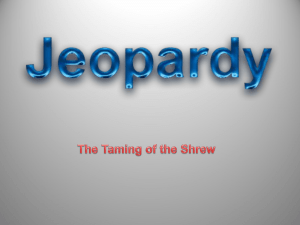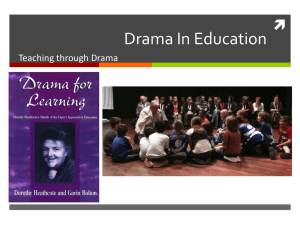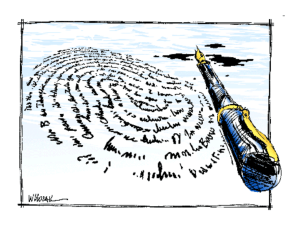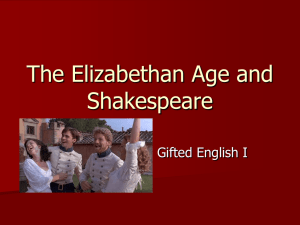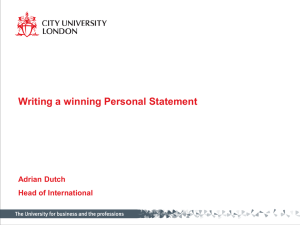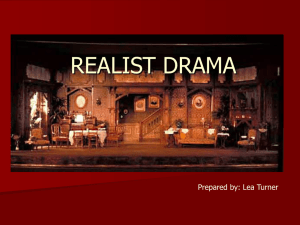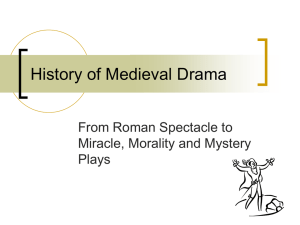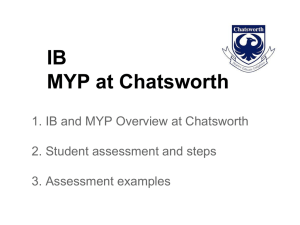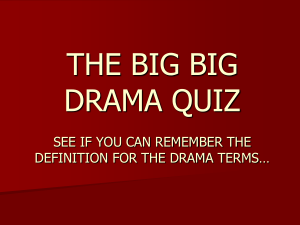Lecture 1 The Taming of the Shrew
advertisement
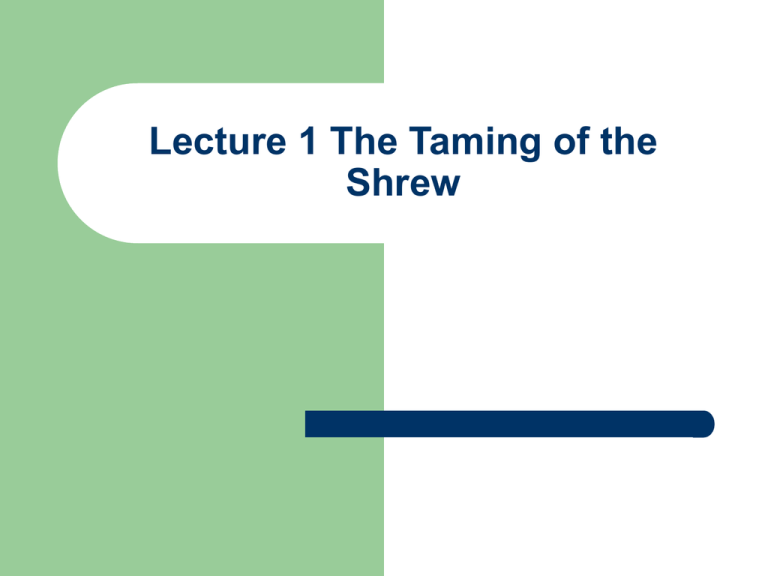
Lecture 1 The Taming of the Shrew All Paper 5 students note CJC recommended text edition of the play Oxford School Shakespeare THE TAMING of the SHREW by William Shakespeare Women in Literature From Tess Durbeyfield to our new Woman in Literature— Katherina Minola The nature of Drama Drama as Literature; Drama and Theatre Shakespearean Drama The Taming of the Shrew Women in Drama ‘Theatre’ from the Greek word “theatron’— a place for seeing Larger meaning: Theatre is pretending, make believe, dress-up games; Theatre is “play” Theatre makers and audiences have always understood the vital part make-believe plays in our lives and our societies In its largest sense, theatre is the human arena for our understanding of the human condition; It reveals human truth by showing truth on stage; For over 2000 years, theatre has thrown a powerful spotlight on the actions, shapes, sounds and meaning of human existence; In the theatre, audiences gather to view and witness thoughts and emotions, shapes and sounds Two Texts Dramatic Text Dialogue Stage Directions To read dialogue alone is to see how one character attempts to persuade another; Theatrical Text Character(s) Dialogue Space Action Actor’s body Costume Special Effects + Audience But what is happening visually on stage is something more than reading on the page ‘The Woman in Black’ staged in Fortune Theatre, Covent Garden Based on the novel by Susan Hill It is the magic of theatre, made possible only by that most precious and under-used of commodities— The audience’s imagination The play relies extremely heavily on this, as all good theatre should Reading a Play? A play is not really a piece of literature for reading; a true play is three dimensional; it is literature that walks and talks before our eyes Essentially drama is written to be seen on the stage rather than read on the page; Performance on stage is the ultimate goal; To learn to read a play is to come to understand its potential for performance in the theatre; We must keep in mind audience impact; Effects Drama is a Performing Art Drama, strictly speaking, is not a branch of Literature; The essence of drama is live performance in front of a live audience; Theatre has an immediacy, a ‘here-and-now’ impact that can create a unique bond between performers and audience; Playwrights write plays for audiences who have assembled in a public place to watch a theatrical performance; theatrical effects / dramatic effects The ‘audience’ for novelists like Hardy or Forster, are individuals sitting by themselves reading words printed on pages; ‘Live’ theatre audiences affect the way actors interpret the dramatists words and actions on stage; Plays thus cannot be analyzed in the same way as novels and short stories, as the though the text on the page is the play Drama and Conflict At the centre of all drama is conflict; Conflict is the essence of drama Conflict as physical or emotional, personal or universal, spiritual, moral or romantic; Realism? Some plays intend to portray real life as it really is, warts and all; Non-Realism: Others plays encourage the audience to “willingly suspend disbelief” (Samuel Coleridge), and believe what they see and hear on stage Conflict in Shakespeare In Shakespeare, conflict can take different forms In Shakespeare’s romantic comedies— Love is the source of conflict; Money (dowry), Power, and beautiful women; Fathers and their daughters; Baptista seeks to dominate and control choices of husbands Conflict and strife of rivals in love Dramatic Convention, Language, and Shakespeare All drama depends on the acceptance of a number of dramatic conventions; Shakespeare: Non-realist, non-naturalistic, relying on theatrical conventions shared by actors and audiences; Few props; elaborate costumes But above all, relying on language and the power of the human voice Stage conventions and language Of heightened, rather than everyday language, often blank verse (unrhymed iambic pentameter); Elizabethan audiences accepted conventions far less used in drama at the present time Long speeches (copia verborum), soliloquies, the aside to the audience, patterned dialogue, prologues and epilogues, complex imagery, antithesis, puns; theatrical illusion, rhyme; noble characters speak in verse; lower status characters speak in prose Dramatic characters Characters in a play are only another form of image, (though the most complex) Projections of the dramatist’s inner vision, Interpreted by directors and actors And re-formed within the minds of audiences of spectators Shakespeare: Words, words, words Atmosphere and setting was achieved through language; Scene painting done in words; Lighting effects achieved through language; For Elizabethan audiences, the fullest experience of any play was created through language, through the spoken word; Dramatic effects achieved through language; The Taming of the Shrew Written 416 years ago, probably 1593? 1594? in fairly early modern English, during the reign of Queen Elizabeth the First; Genre / Type of Play Romantic Comedy? or Romantic Farce? Farce, a dramatic genre that presents for comic effect highly improbable situations, stereotyped characters, and extravagant exaggeration; The play, as much a romantic comedy as it is a farce Setting: rural England, and Padua in Italy A fast-moving comic play exploring various kinds of romance, and fulfillment in marriage; A tale of wife taming; the wooing of Katherina The two opening scenes bring together three of the play’s principal concerns Hunting, acting (disguise and deceit), and the creation of an illusion of a powerfully rich world; The subject matter: The endless battle of the sexes as to which gender outperforms the other; A sense of Plot Structure The audience is in a theatre watching a play about a Lord who makes a play for a tinker, Christopher Sly, Who watches actors perform a play, The Taming of the Shrew, Inside which is a play about the wooing of Bianca, by a love-sick hero, Hortensio, and his rival Bianca worshippers Lucentio and Gremio; Inside that, is another play about, by contrast, the very blatant wooing of Bianca’s older sister, Katherina by Petruchio The first play within a play is Sly as Lord Second, Hortensio and Lucentio are caught up in the business of wooing of Bianca Inside the dramatic action, is the third That of Katherina and Petruchio New Woman in Literature; new woman in drama (Women in Drama) Katherina Minola (daughter of Baptista) Presented as a shrew Shrew? Bad-tempered, nagging, and unruly type of woman A type especially common in England Chaucer’s The Wife of Bath Feminist criticism and Shakespeare Literature and Drama have always played an important role in defining gender; How female experience is portrayed in literature; or in Drama Such criticism attempts to expose how in plays, in novels and other kinds of writing Patriarchal ideology, often stereotypes, distorts, ignores or represses that experience, misrepresenting how women feel, think, act; Women characters have no part in financial deals affecting their lives; women, symbols of male power But… Feminist criticism also acknowledges and celebrates how women contest male power; Shakespeare’s plays also present women as resourceful, self-confident, who create their own space, and achieve spirited independence; Women of very different personalities: Lady Macbeth, Cleopatra, Goneril and Regan, Beatrice, and our Katherina The idea of male superiority is not that apparent in much of Shakespeare It is said, women characters are in fact not only portrayed favorably in all of Shakespeare and most especially in the comedies But are almost invariably presented to be smarter, and more capable, than male characters The Taming of the Shrew, a problem play for feminist literary critics It is a play that has been perceived as being a stark, savage attack on the rights of women That the play is disgusting and barbaric; Several feminist critics assert that Katherina marries Petruchio against her will; (conflict) GB Shaw: ‘The last scene is almost disgusting to modern sensibility. No man with any decency of feeling can sit out in the company of a woman without being extremely ashamed…’ For American Shakespeare scholar, Harold Bloom, that is simply untrue

